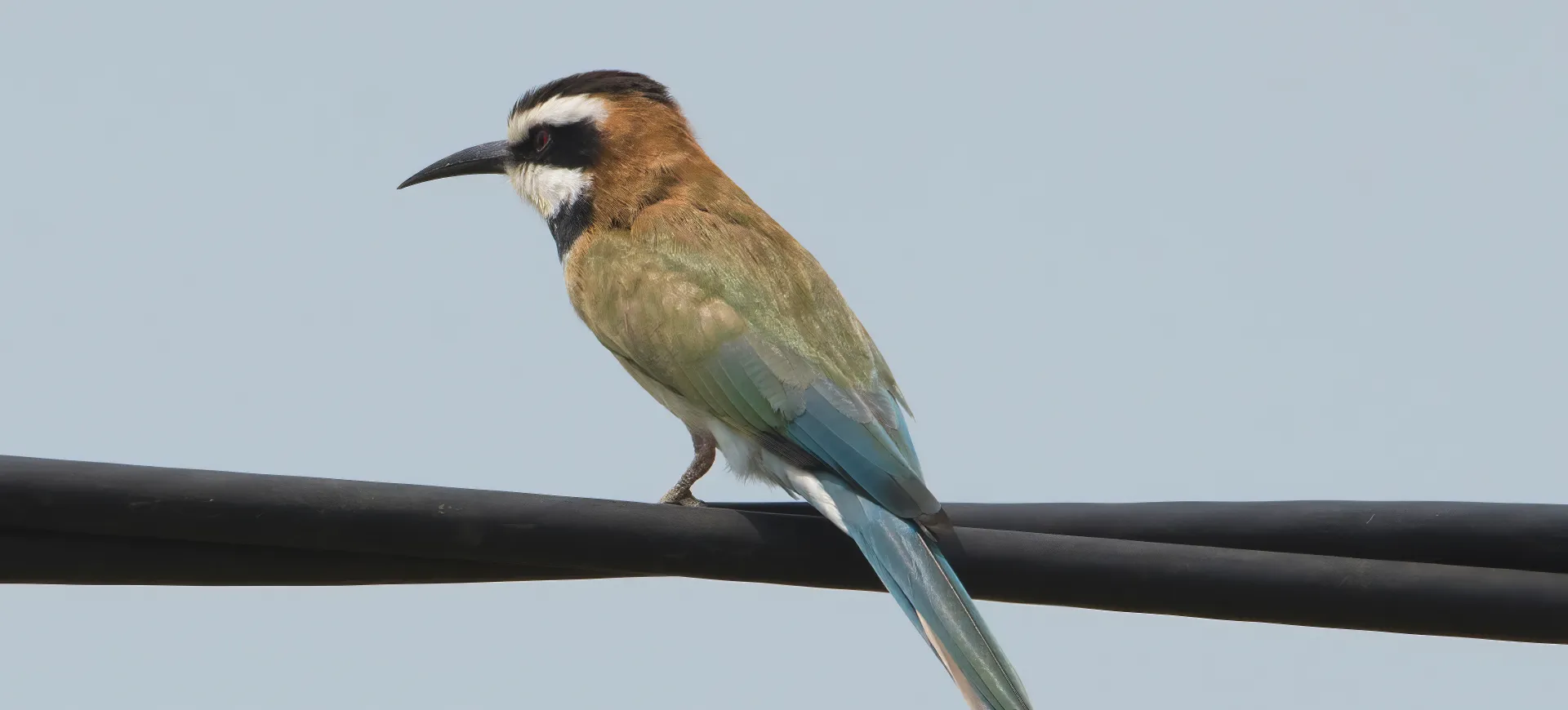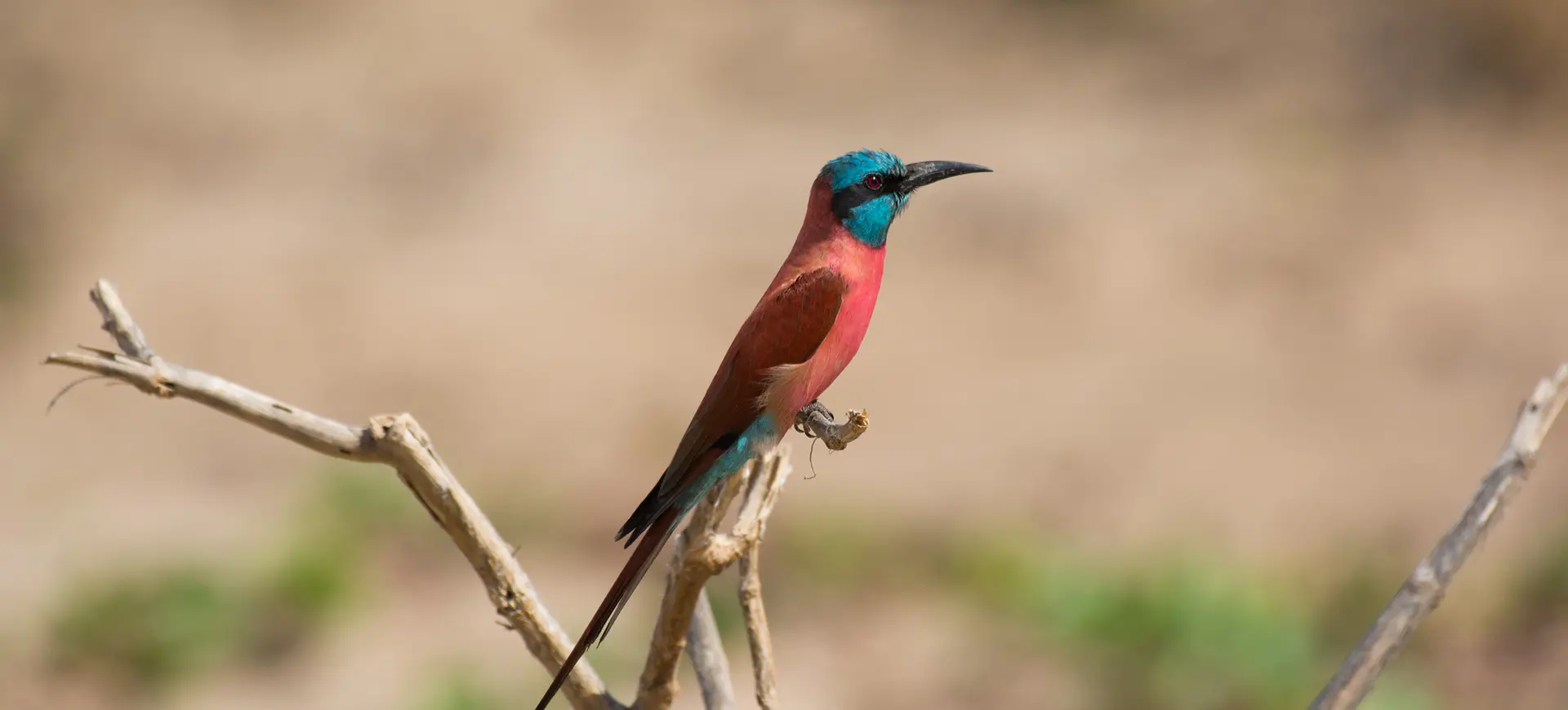Overview
The White-fronted Bee-eater is a brightly colored, slender bird known for its distinctive green, red, and yellow plumage and a characteristic white forehead contrasting sharply with its black mask and beak. Native to the sub-Saharan regions of Africa, it thrives in various wooded environments near rivers, lakes, and cliffs, where it can be seen performing agile flights to catch its primary food source: bees and other flying insects. The bird’s specialized hunting technique involves catching insects in mid-air and returning to a perch to consume them, often beating larger prey against the perch to remove stingers and venom sacs before eating.
Colonial in nature, White-fronted Bee-eaters are highly social, nesting in burrows excavated in vertical riverbanks or cliffs. These communities are structured around complex social systems involving cooperative breeding, where individuals assist in raising the offspring of others in the colony. The species plays a crucial role in controlling insect populations, including bees, wasps, and hornets, thus contributing to the balance of ecosystems where they reside.
Despite facing habitat destruction and degradation threats, particularly due to agricultural expansion and river pollution, the White-fronted Bee-eater remains classified as Least Concern by the IUCN, thanks to its wide distribution and large population. Conservation efforts are essential to preserve their habitats and the continued health of these vibrant bird communities. Public awareness and engagement in conservation practices are key to protecting the natural environments that support the White-fronted Bee-eater and the rich biodiversity of the African landscapes they inhabit.
Taxonomy
Kingdom
Phylum
Class
Order
Family
Genus
Species
Type
Physical Description:
The White-fronted Bee-eater is a medium-sized bird that measures approximately 23-25 cm, including the tail. Its bright green back and wings, yellow throat, and chestnut lower belly are complemented by the striking white forehead and black mask around the eyes and beak, making it one of the more colorful species within its range. The birds exhibit sexual dimorphism, with males and females having similar plumage but differing slightly in size and the intensity of their colors.
Their slender bodies are adapted for agile flight, crucial for catching flying insects, constituting their diet. The long, pointed wings and streamlined body allow for quick maneuvers and sudden changes in direction. The tail is long and forked, aiding in aerial agility, while the sharp, curved beak is perfectly designed for catching and handling insects. Their vibrant colors, graceful flight, and social behavior make the White-fronted Bee-eater a fascinating subject for birdwatchers and nature enthusiasts.

Lifespan: Wild: ~12 years || Captivity: ~15 years

Weight: Male & Female: 0.7–1.2 oz ( 20 to 35 g)

Length: Male & Female: 9-10 inches (23-25 cm)

Wingspan: Male & Female: 11.4-12.6 inches (29-32 cm)

Top Speed: 18 mph (30 km/h)
Characteristic:
Native Habitat:
White-fronted Bee-eaters are found across a broad swath of sub-Saharan Africa, from Senegal and Sudan in the west to Ethiopia and South Africa in the east and south. They favor open woodlands, savannas, and riverine environments where they can find suitable nesting sites in sandy banks or cliffs and abundant food sources. These habitats provide the essential components for their nesting, feeding, and social behaviors.
Their preference for nesting in colonies on riverbanks or cliffs near water bodies significantly influences their distribution, as these environments offer the necessary conditions for their burrow-nesting lifestyle. Conservation of these natural habitats, particularly the preservation of clean, unpolluted waterways and the maintenance of open woodland and savanna areas, is crucial for the survival of White-fronted beef-eater populations.
Climate Zones:
Biomes:
Biogeographical Realms:
Continents:
Diet:
Diet & Feeding Habits:
The diet of the White-fronted Bee-eater primarily consists of bees, wasps, and hornets, which it catches in flight using its agile flying skills. The bird’s hunting technique is remarkable; it launches from a perch to snatch its prey mid-air, then returns to the perch to beat the insect against the surface to remove the sting and venom sac before consumption. This behavior minimizes the risk of injury or poisoning from their prey, showcasing the bird’s adaptation to its diet.
In addition to bees and wasps, their diet can include other flying insects, such as dragonflies and butterflies, depending on availability. The White-fronted Bee-eater plays an important ecological role in controlling insect populations, particularly those of stinging insects, which can be pests to humans and other animals. Their feeding behavior underscores the need for conserving natural habitats that support a diverse range of insect species, ensuring food availability for this and other insectivorous birds.
Mating Behavior:
Mating Description:
White-fronted bee-eaters nest in colonies averaging 200 individuals, digging roosting and nesting holes in cliffs or banks of earth. A population of bee-eaters may range across many square kilometers of savannah but will come to the same colony to roost, socialize, and breed. White-fronted bee-eaters have one of the most complex family-based social systems in birds.
Colonies comprise socially monogamous, extended family groups with overlapping generations, known as “clans,” which exhibit cooperative breeding. Non-breeding individuals become helpers to relatives and assist in raising their brood. This helping behavior is particularly well developed in white-fronted bee-eaters, with helpers assisting in half of all nesting attempts. These helpers may contribute to all aspects of the reproductive attempt, from digging the roosting or nesting chamber to feeding the female, incubating and feeding the young, and greatly increasing the number of young produced. Only 50% of non-breeders in a colony typically become helpers, and whether or not an individual becomes a helper and to whom it provides aid heavily depends on the degree of kinship involved. Non-breeders are most likely to become helpers when breeding pairs are close genetic relatives. When faced with a choice of potential recipient nests, helpers preferentially help the breeding pair to whom they are most closely related. This suggests that this behavior may increase the helper’s inclusive fitness. Female white-fronted bee-eaters leaving their nesting burrows must avoid pursuit by unmated males who may force them to the ground and rape them. Furthermore, their unwelcome attentions are preferentially against females who are laying eggs and who thus might lay the eggs of their rapist rather than their mate.
Reproduction Season:
Birth Type:
Pregnancy Duration:
Female Name:
Male Name:
Baby Name:
Social Structure Description:
The White-fronted Bee-eater’s social structure is characterized by its colonial nesting habits and cooperative breeding behavior. These birds form close-knit communities, with individuals working together to raise the young, defend against predators, and maintain the colony. Social interactions within the colony are complex, involving vocal communications, cooperative foraging, and mutual grooming, which strengthen social bonds and facilitate sharing responsibilities.
The cooperative nature of the White-fronted Bee-eater’s social system is a remarkable aspect of their behavior, illustrating the benefits of social living in the animal kingdom. Conservation of their natural habitats supports not only the physical needs of these birds but also the social structures that are vital for their reproductive success and survival. By protecting these environments, conservation efforts help ensure the continuity of the complex social dynamics that define White-fronted Bee-eater colonies.
Groups:
Conservation Status:
Population Trend:
The White-fronted beef-eater is considered Least Concern by the IUCN, reflecting its wide distribution and relatively large population size. However, the species faces threats from habitat destruction, pollution, and changes in land use, which can lead to localized declines. Conservation efforts focused on protecting natural habitats, especially riverine environments and open woodlands, are crucial for supporting stable populations of White-fronted Bee-eaters.
Public awareness and involvement in conservation practices are key to mitigating the impacts of habitat loss and environmental degradation. Initiatives that promote the sustainable use of land and water resources can contribute to preserving the habitats essential for the survival of the White-fronted Bee-eater and the broader biodiversity of the regions they inhabit. Research and monitoring efforts are also important for tracking population trends and understanding the species’ ecological needs.
Population Threats:
The main threats to the White-fronted Bee-eater include habitat destruction due to agricultural expansion, deforestation, and urban development. Pollution of water bodies and changes in land use also impact their nesting sites and food availability. The alteration of riverine landscapes, which are crucial for their nesting and feeding, poses a significant threat to their populations.
Climate change is another concern, as it can lead to alterations in the ecosystems where White-fronted Bee-eaters reside, affecting food availability and suitable nesting sites. Conservation strategies must address these threats to ensure the species’ long-term survival, emphasizing habitat protection, pollution control, and the sustainable management of natural resources.
Conservation Efforts:
Conservation measures for the White-fronted bee-eaters include the protection of their natural habitats, particularly the preservation of riverbanks, cliffs, and open woodlands where they nest and feed. Efforts to restore degraded habitats and implement sustainable land and water management practices can help mitigate the impacts of human activity on these birds and their environments.
Engaging local communities in conservation actions and raising awareness about the importance of biodiversity and ecosystem health is critical for the success of conservation initiatives. Protected areas and wildlife reserves are crucial in providing safe havens for White-fronted Bee-eaters, allowing their populations to thrive. Research and monitoring programs are also essential for understanding the species’ ecological requirements and informing conservation strategies.
Additional Resources:
Fun Facts
- The White-fronted Bee-eater’s diet helps control populations of stinging insects, providing a natural pest control service in their ecosystems.
- Their cooperative breeding system is rare among birds, showcasing the complexity of their social interactions and the benefits of communal living.
- The vibrant colors of the White-fronted beef-eater make it one of the most visually striking birds in its habitat. Its plumage provides excellent camouflage among the foliage and flowers.
- These birds are skilled flyers, capable of performing intricate maneuvers to catch flying insects, demonstrating their agility and precision.
- The sound of a White-fronted beef-eater colony can be quite loud, with the combined calls and songs creating a distinctive chorus that adds to the auditory landscape of their habitats.
- Conservation efforts for the White-fronted Bee-eater also benefit many other species that share their habitats, underscoring the interconnectedness of ecosystem health and biodiversity conservation.
- The nesting sites of White-fronted Bee-eaters, often located in riverbanks or cliffs, can be reused year after year, with colonies continuously expanding and modifying the tunnels.
- Research on White-fronted Bee-eaters provides insights into the evolution of social behaviors in birds, contributing to our understanding of the factors that drive cooperative breeding and communal living.











